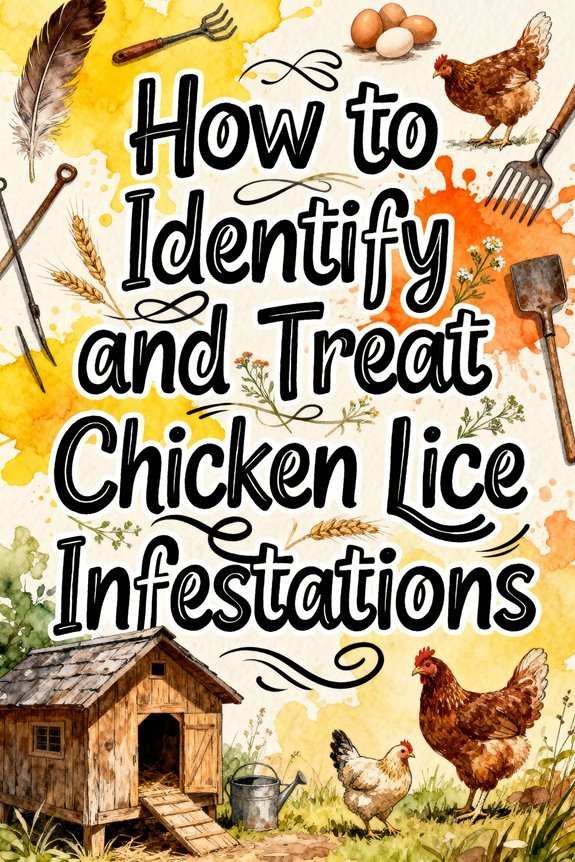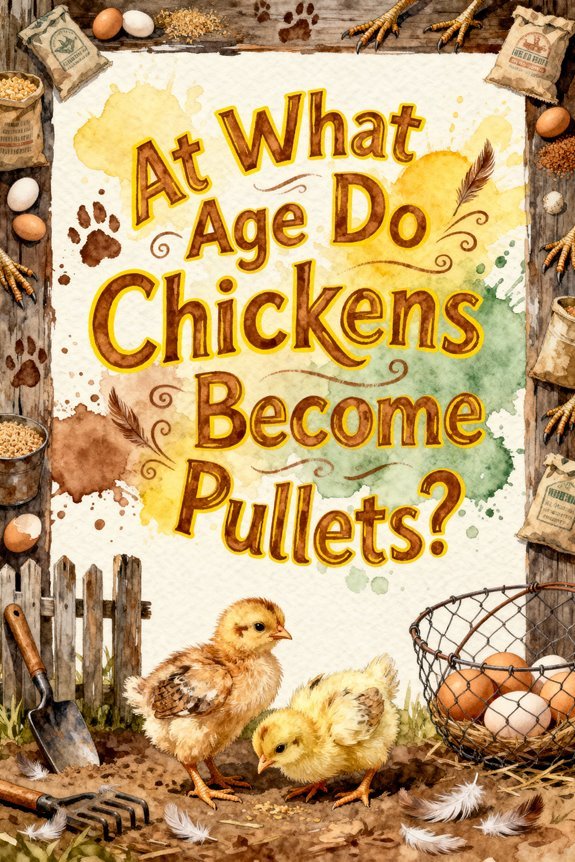How to Identify and Treat Chicken Lice Infestations
You can identify chicken lice by examining your birds’ feathers, particularly near the vent, under wings, and breast areas, for 1-4mm beige parasites and their eggs. Common signs include excessive scratching, tattered feathers, and decreased egg production. Treat infestations with permethrin-based products or natural options like diatomaceous earth, repeating applications every 7-10 days for three weeks. Thorough coop cleaning and quarantine protocols remain essential for complete eradication and future prevention.
Understanding Chicken Lice and Their Impact
Ectoparasites known as chicken lice represent a considerable threat to poultry health and productivity. You’ll encounter several lice types in your flock, including Menacanthus stramineus, which primarily infests the vent and breast areas, and Menopon gallinae, which targets feather shafts. The feeding behavior of these parasites involves chewing on feathers, skin, and dermal debris, though they don’t directly consume blood. These small flat insects measure between 1-4 millimeters in length. They appear as beige colored parasites moving quickly near feather bases.
These parasites can greatly impact your birds’ well-being. You’ll notice affected chickens displaying increased stress, excessive pecking, and reduced egg production. The damage isn’t limited to discomfort; the parasites create potential entry points for secondary infections. While these lice can’t survive on humans, they spread rapidly between birds through direct contact, making prompt identification and treatment essential for maintaining flock health. Unlike mites, which can survive several weeks offhost, lice die within a few days if separated from their chicken hosts.
Common Signs and Symptoms to Watch For
Vigilant observation of your flock is essential for early detection of chicken lice infestations. You’ll notice affected birds exhibiting excessive scratching, preening, and restlessness, often accompanied by behavioral changes including lethargy and reduced activity. Physical symptoms manifest as tattered or missing feathers, particularly around the vent area, along with visible lice and nits attached to feather shafts. Since lice thrive in warm, humid environments, regular inspection becomes even more critical during summer months. Similar to the effects of mite infestations, untreated cases can severely compromise your birds’ immune systems.
Watch for pale combs and wattles, indicating potential anemia from severe infestations. Skin lesions, scabs, and inflammation may develop at feather bases where lice feed. These parasitic infections typically result in decreased egg production and irregular feeding patterns. You’ll observe small, fast-moving lice concentrated around the vent, under wings, and neck regions during examination, while nits appear as white clusters firmly adhered to feathers. Affected birds may show aggressive behavior toward flock mates due to constant irritation.
Where to Look for Lice on Your Chickens
A thorough inspection for chicken lice requires systematic examination of key body areas where these parasites commonly congregate. Begin your inspection at the vent area, where feathers are sparse and lice frequently cluster. Part the feathers to examine feather shafts at their base, paying particular attention to the presence of tiny white egg clusters or fast-moving beige insects. Regular dust bathing helps chickens naturally control these parasitic pests.
Next, check under the wings, breast, and thighs where feathers overlap, creating ideal hiding spots. You’ll need to carefully separate the feathers to observe any movement or signs of infestation. While examining these areas, look for characteristic signs including damaged feathers, redness, scabs, or matted appearance from lice droppings. Watch for signs of decreased activity or listlessness in your chickens as this can indicate a severe infestation. Though less common, also inspect the head and neck regions, as lice occasionally inhabit these areas.
Natural Prevention Methods for Your Flock
While chemical treatments can effectively combat chicken lice, implementing natural prevention methods offers a sustainable, long-term approach to protecting your flock. Establish designated dust bathing areas filled with wood ash or fine dirt, as these natural agents suffocate and dislodge parasites. Supplement these areas with diatomaceous earth for enhanced protection. Rolled cardboard traps help monitor parasite populations and determine when additional treatments are needed.
Maintain strict coop hygiene by removing old bedding regularly and applying preventive layers of wood ash throughout roosting areas. Regular inspections can help detect signs of pale combs and wattles early, indicating potential blood loss from parasites. You’ll need to guarantee proper ventilation to prevent moisture accumulation that attracts parasites. When introducing new birds, implement a two-week quarantine period with thorough health inspections. Apply diluted neem oil (2 tablespoons per gallon of water) as a natural repellent during this period. Checking for parasites during nighttime inspections is most effective since they are more active after dark. This systematic approach disrupts the lice life cycle while avoiding chemical resistance.
Effective Treatment Options and Products
Treating chicken lice effectively requires a multi-pronged approach using both chemical and natural interventions. You’ll find permethrin-based sprays and powders provide immediate contact killing, while injectable ivermectin offers systemic control with an 8-week egg withdrawal period. Elector PSP serves as an effective coop treatment without egg withdrawal restrictions. Research has shown that key compounds like kaempferol and quercetin are present in effective herbal treatments. Maintaining a balanced diet helps strengthen chickens’ natural resistance to parasites.
For organic solutions, polyherbal formulations containing extracts from Asarum europaeum and Lavandula angustifolia demonstrate 76-98% mortality rates. These herbal solutions require application every 7-14 days. Powder treatments, including food-grade diatomaceous earth, can supplement your protocol through dust baths. You’ll need to apply these in well-ventilated areas to prevent respiratory irritation. For severe infestations, combine treatments with manual removal using insecticidal shampoos or soaps, followed by thorough drying.
Cleaning and Sanitizing Your Coop
Successful lice eradication demands thorough coop sanitation alongside your chosen treatment protocols. Begin by removing all bedding materials, organic debris, and detachable components to eliminate potential lice habitats. Relocate your birds temporarily to prevent cross-contamination during the cleaning process.
Execute a systematic sanitization protocol by washing all surfaces with warm, soapy water or appropriate detergents. The process typically requires half a day for smaller coops to complete properly. Apply EPA-registered disinfectants or a vinegar-water solution, focusing on high-contact areas like roosting bars and nesting boxes. For severe infestations, consider using Elector PSP as an effective treatment that won’t affect egg production. Ascertain complete drying through adequate ventilation before introducing fresh bedding materials.
Implement preventive pest control measures by incorporating dusting agents and natural repellents in the renewed bedding. Maintain rigorous biosecurity practices through daily droppings board maintenance, regular equipment cleaning, and proper protective gear during coop maintenance activities.
Breaking the Lice Life Cycle
Thorough disruption of the chicken lice life cycle requires precise timing of treatments across three distinct developmental stages: eggs, nymphs, and adults. You’ll need to implement interventions at specific hatching intervals, as eggs remain viable for 4-7 days before emerging as nymphs.
To effectively break the cycle, schedule treatments every 7-10 days, targeting both existing adults and newly hatched nymphs before they mature. Since eggs aren’t eliminated by most treatments, you must maintain this regimen for at least three weeks to guarantee complete eradication. Monitor your flock closely during this period, paying particular attention to the vent, breast, and thigh areas where eggs are commonly deposited. Regular dust bath treatments with diatomaceous earth and sand provide ongoing prevention while addressing all life stages of the parasites. Wild bird contact poses a significant risk for new infestations, so remain vigilant even after treatment completion. Consider tying wormwood bundles in the coop as a natural deterrent against parasites. This systematic approach addresses all life stages while preventing reinfestation from surviving eggs.
Protecting New Birds and Preventing Spread
While breaking the lice life cycle requires diligent treatment, preventing new infestations demands equally rigorous biosecurity measures. Implement strict quarantine protocols for all new birds, isolating them for a minimum of two weeks while conducting thorough pest inspection for external parasites. Monitor quarantined specimens daily for clinical signs including pruritus, feather loss, and agitation. Warm humid conditions provide an ideal environment for lice reproduction, so maintain proper ventilation in quarantine areas. These parasites are species-specific pests that cannot survive on humans or other animals besides chickens.
You’ll need to maintain separate equipment for quarantined birds to prevent cross-contamination, and only integrate them with your existing flock after confirming parasite-free status. Establish preventive measures by providing designated dust bathing stations containing a calibrated mixture of diatomaceous earth and sand (6:25 ratio). Install physical barriers to prevent wild bird contact, and secure feed storage to minimize external vectors. Apply approved preventive treatments such as pyrethrin-based solutions according to clinical guidelines.
Long-term Health Management Strategies
Maintaining long-term control of chicken lice requires a thorough, multi-faceted approach that integrates environmental management with targeted treatments. To implement effective long-term strategies, you’ll need to establish consistent monitoring protocols and rotate treatment methods to prevent parasite resistance. Consider using botanical insecticidal powders as a safe alternative to harsh chemicals.
Focus on building health resilience through extensive coop management, including weekly inspections, thorough cleaning cycles, and regular bedding replacement. Watch carefully for lethargic or anemic birds that need immediate separation from the flock. Sprinkling food-grade DE in nesting boxes and bedding provides ongoing natural pest control. You’ll need to implement a structured treatment schedule with 7-10 day intervals for 3-4 weeks, while maintaining isolation protocols for affected birds. Incorporate natural preventive measures like dust baths with diatomaceous earth and wood ash, alongside chemical interventions when necessary. For best results, combine these practices with proper nutrition and stress reduction techniques, consulting veterinary expertise for persistent infestations requiring advanced intervention.


